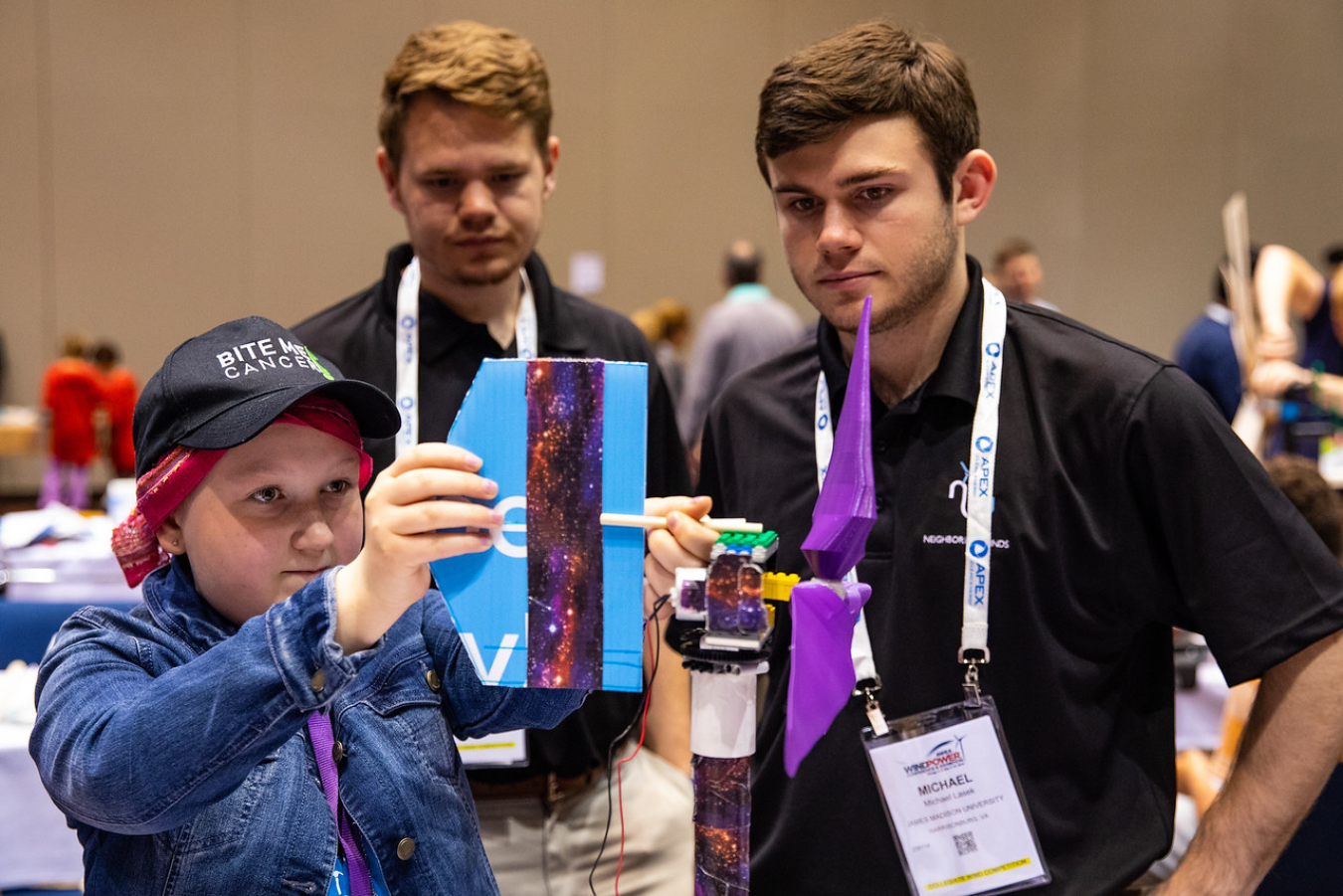Collegiate Wind Competition participants from UW-Madison and James Madison University share their experiences volunteering with KidWind.
June 12, 2019
Volunteers from James Madison University consult with a student during a KidWind Challenge. Photo by Werner Slocum, NREL
The U.S. Department of Energy (DOE) Collegiate Wind Competition (CWC) is an incredible learning opportunity for its college-age participants. Students not only get the chance to design, develop, and test their own wind turbines, but they also connect with industry and potential future employers.
As the students look forward to their own futures in the wind and renewable energy industry, many also take the opportunity to look—and give—back.
These students aren’t far removed from their younger days in middle and high school, and many have a keen sense of how they might have enjoyed the opportunity to work on wind projects back then. Volunteering with the KidWind Challenge allows them to help young students do just that, while honing their teaching and leadership skills and fulfilling the CWC requirement to connect with the community.
KidWind is a program that brings renewable energy education into classrooms around the country, providing educators with curriculum, training, tools, and kits to bring solar and wind energy to life for students in grades 4–12.
KidWind also holds weekend events around the country, known as KidWind Challenges, which allow young students to compete with their peers to design, build, and test a functional wind turbine. Many CWC students volunteer as judges, day-of volunteers, and team mentors.
“Having the Collegiate Wind Competition students work with KidWind is really a great opportunity for the younger kids to see what the next level is,” says Mike Arquin, founder and director of KidWind. “The college kids share what they’re learning with the younger grades.”
Yi “Louis” Liu, a senior mechanical engineering student at the University of Wisconsin–Madison (UW–Madison), agrees. He served as the outreach coordinator for his CWC team, a role that prompted him to seek out events and opportunities to educate the public.
The KidWind Challenge was a perfect fit for UW-Madison’s CWC team. Six team members—one-third of their team—volunteered by helping to organize the Wisconsin KidWind challenge and present on their experiences in CWC. In addition to sparking kids’ interest in wind energy, it was also an opportunity for the team to hone their presentation skills.
“The Collegiate Wind Competition is definitely a great opportunity to compete,” says Louis. “But it’s also a chance for us to practice our technical communication skills. There are many complicated concepts we need to express to an audience who don’t have a technical background. Teaching the kids in the KidWind Challenge gives us a chance to practice that.”
Scott Williams, who serves as the research and education coordinator for the Wisconsin Energy Institute at UW–Madison, also sees the benefits for the CWC teams.
“KidWind gets our students out in the community and helps them see what people are interested in. They can share what they’re doing with a public audience, outside of the university. It really improves their communication skills,” says Williams.
James Madison University (JMU) goes beyond just offering KidWind as an option—the university requires that all CWC team members volunteer in at least one KidWind Challenge during the academic year.
JMU also tries to extend its relationship with the young KidWind students. After the regional KidWind Challenge, JMU hosts a winners’ review challenge for the top middle and high school teams from the regional challenge to prepare for the National KidWind Challenge, to be held this year in Houston, Texas, at the American Wind Energy Association WINDPOWER Conference.
The winners’ review challenge is a chance for the teams to go through the process again and get more feedback. In 2018, the review coincided with JMU and Virginia Tech’s dry runs before the Collegiate Wind Competition.
“The dry run and winners’ challenge allowed the KidWind teams to see the college students in action and get access to the university’s instrumentation and turbines,” says Professor Jon Miles of JMU. “Judges that came for the CWC dry runs gave the KidWind teams feedback on their projects as well.”
With 33 different state- or regional-level KidWind events, there are many opportunities for CWC teams to connect with the young students who could be their future CWC teammates—or coworkers.
“Working with these kids is another reason to get excited about being on the team,” says Louis. “If we can give them a taste of what the Collegiate Wind Competition is like, hopefully we’ll spark their interest in wind energy and in joining a team in college.”

